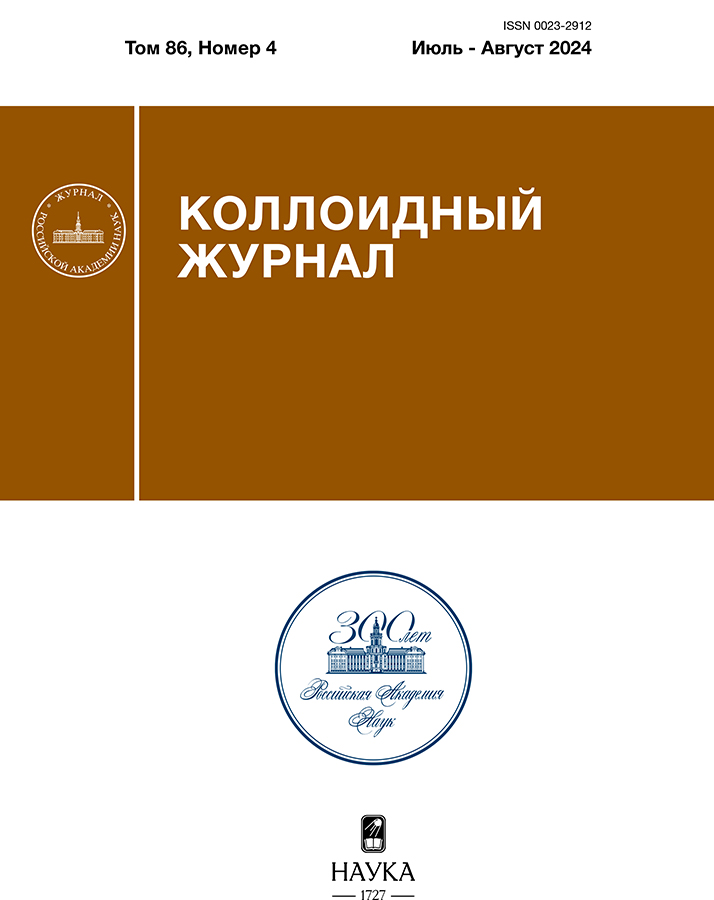A magnetic fluid stabilized by a double layer of surfactant in water rejects known models of rheology and dipole-dipole interaction
- 作者: Lebedev A.V.1
-
隶属关系:
- Институт механики сплошных сред УрО РАН
- 期: 卷 86, 编号 4 (2024)
- 页面: 458-468
- 栏目: Articles
- ##submission.dateSubmitted##: 27.02.2025
- ##submission.datePublished##: 21.10.2024
- URL: https://rjmseer.com/0023-2912/article/view/670864
- DOI: https://doi.org/10.31857/S0023291224040054
- EDN: https://elibrary.ru/caerho
- ID: 670864
如何引用文章
详细
Three samples of magnetic fluid based on magnetite particles stabilized by a double layer of surfactant in water were synthesized. To stabilize the samples, lauric, oleic acids and their salts were used in three different combinations. The viscosity of the synthesized samples was measured as a function of concentration, temperature, and shear rate. With increasing temperature, the viscosity of a liquid sample stabilized by a double layer of lauric acid does not decrease relative to the viscosity of water, as was previously observed for classical magnetic fluids, but increases. For a sample stabilized by two layers of lauric and oleic acids, the temperature dependence of relative viscosity is non-monotonic. The relative viscosity of a sample stabilized with a double layer of oleic acid is practically independent of temperature.
To determine the concentration of the samples, measurements of magnetization curves were carried out, followed by their granulometric analysis. It has been established that the dispersed composition of the samples remains unchanged when diluted. The initial susceptibility of liquid samples was found to increase more slowly with increasing concentration than predicted by the modified effective field model. In contrast to the MEP model (and not only it), the coefficient of the quadratic term in the expansion of the initial susceptibility in the Langevin susceptibility series turned out to be significantly less than 1/3. Thus, to describe the properties of magnetic fluids stabilized with a double layer of surfactants, the construction of new theories of dipole-dipole interaction of particles is required.
全文:
作者简介
A. Lebedev
Институт механики сплошных сред УрО РАН
编辑信件的主要联系方式.
Email: lav@icmm.ru
俄罗斯联邦, ул. Академика Королева, 1, Пермь, 614018
参考
- Шлиомис М.И. Магнитные жидкости // УФН. 1974. Т. 112. № 3. С. 435–458.
- Rosensweig R.E. Ferrohydrodynamics, Cambridge University press, Cambridge, 1985.
- Shimoiizaka J. Method of preparing a water-base magnetic fluid. Pat. 4094804, 1978.
- Лебедев А.В. Аномалии вязкости магнитной жидкости, стабилизированной двойным слоем ПАВ в воде // Известия Юго-Западного государственного университета. Серия: Техника и технологии. 2023. Т. 13. № 4. С. 88–97. https://doi.org/10.21869/ 2223-1528-2023-13-3-88-97
- Khalafalla S.E., Reimers G.W., Rholl S.A. Dilution stable water based magnetic fluids. Pat. 4208294, 1979.
- Elmore W.C. On preparation of the magnetite high dispersed // Phys. Rev. 1938. V. 54. № 4. P. 309–310. https://doi.org/10.1103/PhysRev.54.309
- Chong J.S., Christiansen E.B., Baer A.D. Rheological properties of concentration suspensions // J. Appl. Polym. Sci. 1971. V. 15. № 8. P. 2007–2021. https://doi.org/10.1002/app.1971.070150818
- Vand V. Viscosity of solutions and suspensions. I. Theory // J. Phys. Colloid Chem. 1948. V. 52. № 2. P. 277–299. https://doi.org/10.1021/j150458a001
- Chow T.S. Viscoelasticity of concentrated dispersions // Phys. Rev. E. 1994. V. 50. № 2. P. 1274–1286. https://doi.org/10.1103/PhysRevE.50.1274
- Пшеничников А.Ф., Гилев В.Г. Реология и намагниченность концентрированных магнетитовых коллоидов // Коллоид. журн. 1997. Т. 59. № 3. С. 372–379.
- Лебедев А.В. Вязкость концентрированных коллоидных растворов магнетита // Коллоид. журн. 2009. Т. 71. № 1. С. 78–83.
- Pshenichnikov A.F., Mekhonoshin V.V., Lebedev A.V. Magneto-granulometric analizis of concentrated ferrocolloids // J. Magn. Magn. Mater. 1996. V. 161. P. 94–102. https://doi.org/10.1016/S0304-8853(96)00067-4
- Ivanov A.O., Kuznetsova O.B. Magnetic properties of dense ferrofluids: An influence of interparticle correlations // Phys. Rev. E. 2001. V. 64. P. 041405. https://doi.org/10.1103/PhysRevE.64.041405
- Bean C.P., Jacobs I.S. Magnetic granulometry and super‐paramagnetism // J. Appl. Phys. 1956. V. 27. № 12. P. 1448–1452. https://doi.org/10.1063/1.1722287
- Chantrell R.W., Popplewell J., Charles S.R. Measurements of particle size distribution parameters in ferrofluids // IEEE Transactions on Magnetics. 1978. V. 14. № 5. P. 975–977. https://doi.org/10.1109/TMAG.1978.1059918
- Kaiser R., Mishkolczy G. Magnetic properties of stable dispersions of subdomain magnetite particles // J. Appl. Phys. 1970. V. 41. № 3. P. 1064–1072. https://doi.org/10.1063/1.1658812
- Пшеничников А.Ф., Лебедев А.В., Радионов А.В., Ефремов Д.В. Магнитная жидкость для работы в сильных градиентных полях // Коллоид. журн. 2015. Т. 77. № 2. С. 207–212. https://doi.org/10.7868/S0023291215020159
- Лебедев А.В. Дипольное взаимодействие частиц в магнитных жидкостях // Коллоид. журн. 2014. Т. 76. № 3. С. 363–370. https://doi.org/10.7868/S0023291214030100
补充文件


















